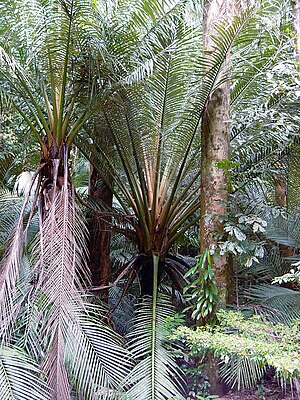Oraniopsis appendiculata
| Oraniopsis appendiculata | ||||||||||||
|---|---|---|---|---|---|---|---|---|---|---|---|---|

Oraniopsis appendiculata |
||||||||||||
| Systematics | ||||||||||||
|
||||||||||||
| Scientific name of the genus | ||||||||||||
| Oraniopsis | ||||||||||||
| ( Becc. ) J.Dransf. | ||||||||||||
| Scientific name of the species | ||||||||||||
| Oraniopsis appendiculata | ||||||||||||
| ( FMBailey ) J.Dransf. |
Oraniopsis appendiculata is a species of palm nativeto Australia . It is the only representative of the genus Oraniopsis . It is a very slow-growing palm whose rosette stage lasts for several decades.
features
Oraniopsis is similar to the closely related genera Ceroxylon and Juania , but differs from them in the following combination of features: The petals are free, the flowers have six stamens , and the remnants of stigmas on the fruits are basal.
They are medium-sized, solitary, unreinforced palm trees that are diocesan and bloom several times. The trunk is upright and sometimes very high, the leaf scars are not noticeable. The numerous leaves are pinnate, the segments are reduplicat folded (Λ-shaped). They point upwards and remain on the plant after they die (marzescence): several dead leaves hang down vertically before they fall off after a while. The leaf sheath is tubular at first, but tears open over time. The petiole is rather short. The blade consists of many simply folded segments that are stiff and linear with an irregularly pointed or pointed end.
The inflorescences stand individually in the axils of the leaves, are shorter than the leaves, male and female inflorescences are similar. They are fourfold. The ovary is dreifächrig with one ovule . The fruit develops from only one carpel , is round with a smooth exocarp that is yellow when ripe and a rather fleshy mesocarp , which contains fibers and stone cells. An endocarp is not differentiated.
The number of chromosomes is unknown.
Distribution and locations
Oraniopsis appendiculata is restricted to the Australian state of Queensland , where it occurs in the rainforests of the mountains from the Tully River area to the Big Tableland . The main occurrences are between 300 and 1500 m above sea level above granite and metamorphic rock. It is also rarely found on shallow basaltic soils with limited water drainage.
Systematics
Oraniopsis is classified within the family in the subfamily Ceroxyloideae , tribe Ceroxyleae . The genus is monotypical, it consists of the only species Oraniopsis appendiculata . Their systematic position within the tribe is not entirely clear, studies see them as a sister group of Ravenea or as a sister group of the group from Ceroxylon and Juania .
In the World Checklist of Selected Plant Families of the Royal Botanic Gardens, Kew , only the species Oraniopsis appendiculata is recognized.
The name Oraniopsis means similar to the genus Orania . The genus was originally a section of Orania , with which it is not closely related.
supporting documents
- John Dransfield, Natalie W. Uhl, Conny B. Asmussen, William J. Baker, Madeline M. Harley, Carl E. Lewis: Genera Palmarum. The Evolution and Classification of Palms . Second edition, Royal Botanic Gardens, Kew 2008, ISBN 978-1-84246-182-2 , pp. 341-343.
Individual evidence
- ↑ Rafaël Govaerts (ed.): Oraniopsis. In: World Checklist of Selected Plant Families (WCSP) - The Board of Trustees of the Royal Botanic Gardens, Kew . Retrieved February 4, 2011.
Web links
- Oraniopsis on the homepage of the Fairchild Tropical Botanic Garden